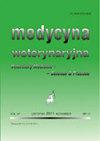浣熊患胆道贾第虫病
IF 0.4
4区 农林科学
Q4 VETERINARY SCIENCES
Medycyna Weterynaryjna-Veterinary Medicine-Science and Practice
Pub Date : 2023-01-01
DOI:10.21521/mw.6799
引用次数: 0
摘要
贾第虫病是由一种世界性的原虫十二指肠贾第虫引起的最重要的胃肠道疾病之一。该感染发生在许多动物中,包括野生浣熊(原浣熊),它们可能在将贾第鞭毛虫囊传播到环境中并将其传播给人类和家畜方面发挥作用。贾第虫病有多种临床表现,包括腹泻、腹部痉挛、胃部不适或恶心。活跃的滋养体通常附着在十二指肠和空肠上部的粘膜上,但很少有人类胆鞭毛虫病的报道。本研究的目的是分析贾第虫在浣熊胆囊中的定位情况。从34只实验动物身上收集的胆汁和粪便样本用于研究。贾第鞭毛虫特异性抗原通过粪便和胆汁样品的快速免疫层析检测。总患病率为38.2% (13/34,95% CI, 21.0 ~ 55.4%)。8份粪便标本阳性率为23.5% (95% CI, 8.5 ~ 38.6%), 13份胆汁标本阳性率为38.2% (95% CI, 21.0 ~ 55.4%)。在所有粪便阳性的浣熊中,通过胆汁检查证实感染。其中5例仅从胆汁样本中获得阳性结果。在所研究的浣熊的胆汁中检测到特异性抗原GSA65,证实了与人类类似,在贾第鞭毛虫感染过程中的动物中,滋养体也可以定位在肠道和胆管中。本文章由计算机程序翻译,如有差异,请以英文原文为准。
Biliary giardiasis in raccoons (Procyon lotor)
Giardiasisis one of the most significant gastrointestinal diseases caused by a cosmopolitan protozoa Giardia duodenalis. The infection occurs in many animals, including wild raccoons (Procyonlotor), that may play a role in disseminating Giardia cysts into the environment and transmitting it to humans and domestic animals. Giardiasis has various clinical manifestations, including diarrhea, abdominal cramps, and upset stomach or nausea. Active trophozoites normally attach to the mucous membrane of the duodenum and upper jejunum, however few cases of biliarygiardiasis have been reported in humans. The aim of this study was to analyze the occurrence of Giardia localization in the gall bladder of raccoons. Bile and feces samples collected from each of the 34 test animals were used for the study. Giardia specific antigen was detected by a rapid immunochromatographic test using stool and bile samples. The overall prevalence was 38.2% (13/34, 95% CI, 21.0-55.4%). Positive results were obtained from 8 stool samples 23.5% (95% CI, 8.5-38.6%) and 13 bile samples 38.2% (95% CI, 21.0-55.4%). In all stool-positive raccoons, the infestation was confirmed by bile examination. In five cases a positive result was obtained only from the bile sample. The detection of the specific antigen GSA65 in the bile of the studied raccoons confirms that, similarly to humans, also in animals in the course of Giardia infection trophozoites can be localized both in the intestine and in the bile ducts.
求助全文
通过发布文献求助,成功后即可免费获取论文全文。
去求助
来源期刊

Medycyna Weterynaryjna-Veterinary Medicine-Science and Practice
VETERINARY SCIENCES-
CiteScore
0.80
自引率
0.00%
发文量
73
审稿时长
4-8 weeks
期刊介绍:
"Medycyna Weterynaryjna" publishes various types of articles which are grouped in the following editorial categories: reviews, original studies, scientific and professional problems, the history of veterinary medicine, posthumous memoirs, as well as chronicles that briefly relate scientific advances and developments in the veterinary profession and medicine. The most important are the first two categories, which are published with short summaries in English. Moreover, from 2001 the editors of "Medycyna Weterynaryjna", bearing in mind market demands, has also started publishing entire works in English. Since 2008 the periodical has appeared in an electronic version. The following are available in this version: summaries of studies published from 1999 to 2005, full versions of all the studies published in the years 2006-2011 (in pdf files), and full versions of the English studies published in the current year (pdf). Only summaries of the remaining studies from the current year are available. In accordance with the principles accepted by the editors, the full versions of these texts will not be made available until next year.
All articles are evaluated twice by leading Polish scientists and professionals before they are considered for publication. For years now "Medycyna Weterynaryjna" has maintained a high standard thanks to this system. The review articles are actually succinct monographs dealing with specific scientific and professional problems that are based on the most recent findings. Original works have a particular value, since they present research carried out in Polish and international scientific centers.
 求助内容:
求助内容: 应助结果提醒方式:
应助结果提醒方式:


